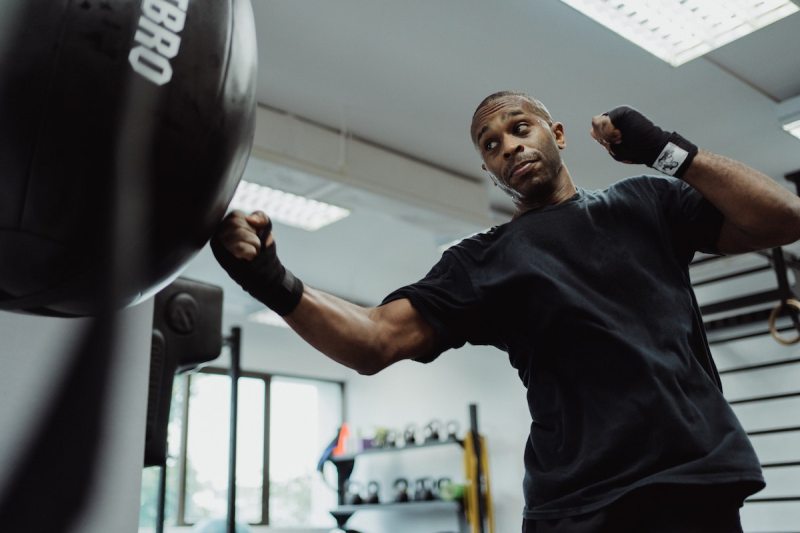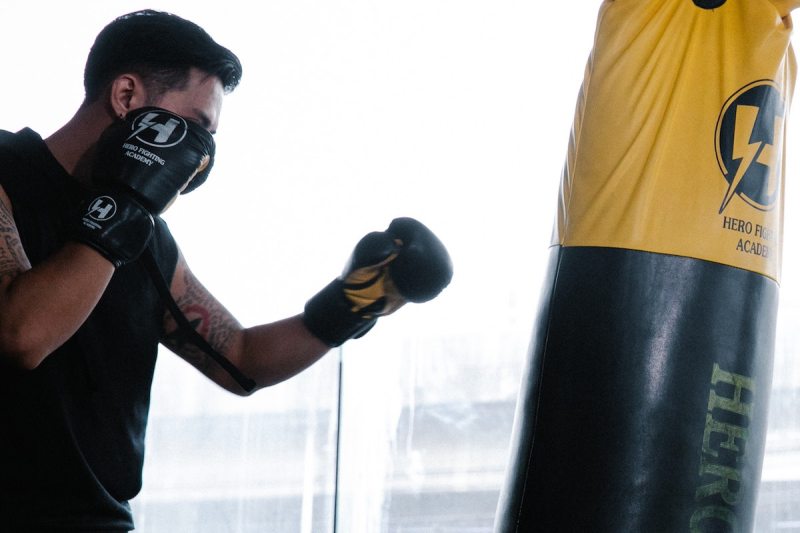
Whether boxing is your go-to when it comes to working out or you just enjoy putting on your gloves every once in a while, you are likely well-acquainted with the punching bag. No one can deny that a good punching bag workout can make you break a serious sweat, help you build muscle, and improve cardiovascular fitness simultaneously!
However, unless you have training in boxing, have taken boxing classes, or use guided boxing workouts, it can be hard to know what to do besides throwing a few stiff punches and quick jabs at the punching bag. How do you put together a whole punching bag workout? What sorts of boxing moves and drills can you string together to make you a better boxer, burn calories, or improve your fitness? What is the best punching bag exercise routine for beginners?
Below, you’ll find answers to these questions with several of the best punching bag workouts so you can step up to the heavy bag with confidence that you’re going to break and sweat and look like you’re well on your way to becoming a champion fighter.

What is a punching bag?
Punching bags and heavy bags may refer to slightly different things, but they are similar. A heavy bag is typically a 50-150-pound cylindrical bag that hangs from the ceiling and it is used for punching, kicking, and practicing boxing moves. A punching bag is a broader term that can encompass heavy bags as well as freestanding weighted punching bags. Both provide resistance when you strike it, in proportion to their weight and construction. For this reason, punching bag workouts for strengthening and technique are beneficial over shadowboxing.
Benefits of punching bag workouts
Punching bag workouts aren’t just reserved for professional boxers and guys who are hooked on boxing. Even beginners can reap plenty of fitness benefits by giving a punching bag workout a go. The benefits of punching bag workouts go far beyond just strengthening your arms and include the following:
- Burning calories and improving overall fitness
- Improving boxing technique
- Practicing combos and moves
- Practicing defense
- Increasing core stability
- Building cardiovascular endurance
- Increasing muscular strength and power
- Improving coordination and balance
- Improving agility
- Practicing footwork
- Reducing stress and aggression

Best punching bag workouts
Ultimately, you can create an infinite number of great punching bag workouts by altering the combos and rounds you string together. The best punching bag workouts usually are aimed at one specific goal, such as practicing new combos for beginners, building endurance, or improving fitness in a HIIT-style workout. Below, we share one of each.
Best punching bag workout for beginners
This 30-minute workout is a perfect way for beginner boxers to practice different punches, work on technique and accuracy, develop coordination, and improve overall fitness.
- Warmup: (5 minutes): Two minutes of jumping rope, one minute of jumping jacks, and two minutes of jumping rope. Then complete two rounds of the following:
- Round 1: Around-the-world jabs (3 minutes): Move back and forth all the way around the bag as you throw alternating right and left jabs.
- Round 2: build-ups (3 minutes): Cycle through right and left rounds of the following:
- Jab
- Jab, cross
- Jab, cross, hook
- Jab, cross, hook, cross
- Round 3: Alternating combos (3 minutes): The first combo should be completed with your rear hand:
- Rear uppercut
- Cross
- Hook
- Round 3 – The second combo should be performed with your lead hand:
- Jab
- Lead hook
- Cross (this is the exception; use your rear hand to cross)
- Round 4: Speedy straight punches (2 minutes): Get your heart rate up by alternating fast, straight punches at the bag.
- Cooldown: Three minutes of stretching

Best endurance punching bag workout
This 30-minute punching bag workout will build your stamina while honing your boxing technique and improving your overall fitness. After the warmup, all rounds are 2 minutes.
- Warmup: (5 minutes): Two minutes of jumping rope, one minute of high knees, two minutes of jumping rope. Then complete two rounds of the following:
- Round 1: Cycles of 10 cross punches with your dominant side, 10 cross punches with your non-dominant side.
- Round 2: Dominant side cycles of
- Lunge
- Jab and kick
- Jab, jab, power punch
- Round 3: Non-dominant side cycles of
- Lunge
- Jab and kick
- Jab, jab, power punch
- Round 4: Cycles of
- 10 burpees
- Right uppercut, jab, jab, hook, cross
- Bob and weave
- Left uppercut, jab, jab, hook, cross
- Round 5: Cycles of
- 10 reps of right-side kicks
- 30 straight punches
- 10 reps of left side-kicks
- 30 straight punches
- Round 6: All-out alternating power punches
- Cooldown: Stretching

Best HIIT punching bag workout
This 20-minute metabolic conditioning workout will torch calories and get your heart pounding.
Perform each exercise for 30 seconds and then rest for 10 seconds before moving on to the next exercise. Complete five rounds of the circuit.
- Warmup: Two minutes of jumping rope.
- Round 1: Straight, powerful punches using a right-left-left-right combo.
- Round 2: Burpees
- Round 3: Cycles of one right kick, one left kick, three right kicks, and three left kicks.
- Round 4: High knees sprinting
- Round 5: Cycles of:
- Jab, cross
- Uppercut
- Cross, hook
- Uppercut
- Hook, cross
- Uppercut
- Round 6: Pushups with alternate shoulder taps
- Cooldown: Stretching
Tips and tricks for the best punching bag workouts
- Properly wrap your hands to protect your knuckles.
- Be sure to warm up and cool down before and after each workout.
- Practice your footwork by moving around the bag with each drill rather than standing in the same relative area.
- Focus on form, speed, and accuracy when striking the punching bag.
- Remember to breathe, fighting the tendency to hold your breath.

Can you do a punching bag workout daily?
As for the question about whether you should be working out with the punching bag every day, the answer depends on your personal situation.
If your name is Rocky Balboa and you have a big fight with Apollo Creed coming up, then by all means, hit that bag every day. But for the rest of us mere mortals, the answer is different. You could theoretically hit the bag every day as long as you don’t have any injuries to your hands and your muscles aren’t overly fatigued. However, the general rule is to not overwork one part of your body, and since the primary function of a punching bag is to build strength and power, you will want to limit your punching bag workouts to two to three times per week and mix in other workouts, including cardio on the days you aren’t hitting the bag.



